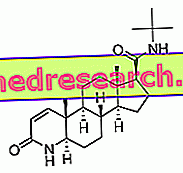
Generality
Finasteride is an antiandrogen drug with an azosteroid structure, which acts as an inhibitor of the enzyme 5-alpha reductase type II.
The use to which finasteride was initially intended was limited to the treatment of benign prostatic hypertrophy and prostate cancer.

Discovery and Development
It all started in 1974, when researcher Julianne Imperato-McGinley of Cornell Medical College in New York presented her research at a conference on birth defects, conducted on a group of hermaphrodite children from the Caribbean islands. These children, who had an ambiguous sexuality at birth, were initially raised as females, also considering the small size of the male organs.
However, during puberty these individuals had developed male organs and other androgenic features typical of the post-pubertal period. From the deepening of the studies it was certified that all these children had in common a genetic mutation that caused a reduced availability of the enzyme 5-alpha reductase and of the male hormone dihydrotestosterone, whose deficiency was responsible for the abnormal sexual development.
After the period of puberty, with sexual maturation, it was noted that all individuals had a smaller prostate than normal.
In 1975 at the then research chief of the pharmaceutical company Merck, P. Roy Vangelos, the results of the study of the researcher Imperato-McGinley were presented; analyzing the data he was intrigued by the fact that the deficiency of the hormone dihydrotestosterone led to an underdevelopment of the prostate; he then decided to start work to synthesize an inhibitor of the 5-alpha reductase enzyme capable of recreating the condition that occurred in the studied hermaphrodite children, namely the reduction in prostate size; all this to address the use of the drug to the treatment of elderly people suffering from benign prostatic hyperplasia.
Thus, after years of research, in 1992 the pharmaceutical company Merck obtained approval from the Food and Drug Administration for the marketing of finasteride, indicated in the treatment of benign prostatic hypertrophy in 5 mg tablets, under the registered name of Proscar ® . In Italy the sale of the Proscar was authorized in 1997.
The license of the pharmaceutical company Merck on the Proscar expired in 2006; since then the finasteride is also marketed as a generic drug under the names: Finasteride ®, Asterid ®, Finastid ®, Finestar ®, Prostide ®, Genaprost ® etc.
It has been proven that more than six months of treatment are needed to appreciate the drug's benefits on benign prostatic hyperplasia; if the intake of finasteride is interrupted or discontinued, the positive effects that follow the treatment could regress
Use in androgenetic alopecia
Considering the studies on the inhibitory effect of finasteride on the enzyme 5-alpha reductase, and also based on other studies that showed that the hormone dihydrotestosterone is responsible for hair loss in androgenetic alopecia, we tried to find a possible use of finasteride also in the treatment against hair loss.
Then in 1997 the pharmaceutical company Merck obtained approval from the Food and Drug Administration to market finasteride, in 1 mg tablets, for the treatment of androgenetic alopecia in the United States, under the registered name of Propecia ® .
In Italy the marketing of Propecia took place in 1999.
Propecia remained protected by the patent until 2013, after which it was also possible to market the generic specialties of the same.
Effectiveness
To test the effectiveness of finasteride in combating hair loss associated with androgenetic alopecia, a 5-year study was performed with patients complaining of considerable, but not excessive hair loss. At the end of the study it was confirmed that in 2 patients out of 3 not only had hair loss been successfully counteracted, but even new hair regrowth had occurred.
In the same study it was confirmed by photographs and by a group of independent dermatologists that during treatment with 1 mg of finasteride per day, in 42% of patients hair loss had stopped and in the remaining 48% of the sample not only had stopped the fall, but there was also a considerable regrowth of hair.
Based on clinical studies it was confirmed that finasteride, in the treatment of androgenetic alopecia, works only if administered for long periods; in case of treatment interruption the fall resumes within 6 months.
Action mechanism
Testosterone in males is produced by the testicles and to a small extent by the adrenal glands.
Most of the testosterone in the body is found bound to a glycopreteine produced by the liver, which transports the hormone into the bloodstream and prolongs its half-life, preventing its metabolism during transport, hematoma; this glycoprotein is called the sex hormone binding globulin (SHBG).
Once freed from the sex hormone binding globulin, testosterone is free to spread into the surrounding environment. However, in certain tissues, such as the skin, scalp and prostate, testosterone is converted into dihydrotestosterone by the enzyme 5 -alpha reductase type II.
However, dihydrotestosterone is a more potent androgen than testosterone and has a greater affinity for the androgen receptor, so it can be deduced that the enzyme 5-alpha reductase type II is an enhancer of the androgenic effect of testosterone in the aforementioned tissues.
Thus finasteride acts as a competitive inhibitor (competing with testosterone, replacing it) of the enzyme 5-alpha reductase type II; all this becomes possible thanks to its structure very similar to that of testosterone, which allows it to bind itself to the same site of action in the enzyme; however, not being equal to testosterone, finasteride remains attached to the enzyme by exploiting its pharmacological properties, thus making it possible to block the enzyme 5-alpha reductase type II.
The consequent reduction of dihydrotestosterone in the scalp allows the reduction of hair loss, while the reduction of dihydrotestosterone in the prostate makes it possible to reduce the volume of the prostate itself, improving the clinical picture that accompanies benign prostatic hypertrophy.



